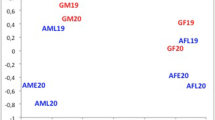Abstract
The scientific value of isolated human populations is important for the understanding of ethnic formation, or for micro-evolution. The population of Sarakatsani in HELLAS was nomadic up to 10–15 years ago. It may still be considered as nomadic since it migrates during winter and summer.
We studied three Sarakatsanic groups, geographically isolated in Epirus, Central Macedonia and Peloponessos.
Nine cephalometric variables were measured and subjected to Discriminant Function Analysis (DFA) and Analysis of Variance (ANOVA). The latter showed that 55% of the variables indicate a statistically significant difference. The former showed that only the Peloponesean population is well differentiated. The groups from Epirus and Macedonia differentiated between them less, compared to the Peloponesean group.
Similar content being viewed by others
References
Allen J.A., 1977. The influence of physical conditions in the genesis of species,Radical Review, 1: 108–140.
Beals, K., 1972. Head form and climatic stress,Amer. J. of Phys. Anthropo. 37: 85–92. Bergmann, C. (1897): Uber Verhaltnisse der Warmeokonomie des Thietezu ihreh Grosse,Gottinger Studien, 3: 597–708.
Bernard R., 1971.Anthropological Subjects (in Greek), Athens Univ. Press.
Chatzimichali A., 1957.Sarakatsani, Athens.
Campbell J.K., 1965.Honour, family and patronage. Oxford, Clarendon Press.
Crognier E., 1981a. Climate and anthropometric variations in Europe and the Mediterranean area.Annals of Human Biology, vol. 8, Nb. 2: 99–107.
Crognier E., 1981b. The influence of climate on the physical diversity of European and Mediterranean Populations.Journal of Human Evolution, vol. 10: 611–614.
Herskovitz E. et al., 1983. Migration and Biological Isolation of Human Population,Anthropos, vol. 10: 344–356.
Hiernaux J., 1963. Heredity and environment: their influence on human morphology. A comparison of two independent lines of study. Amer. J. Phys. Anthropo. 21: 575–589.
Hoeg C., 1925.Les Sarakatsane, une tribu nomade Greque. Copenhagen.
Howells W.W., 1966. Population Distances: Biological, Linguistic, Geographical, and Environmental.Current Anthropology, vol. 7: 531–540.
Howells W.W., 1969. The use of Multivariate techniques in the study of skeletal populations.Amer. J. Phys. Anthropo. 31: 311–314.
Howells W.W., 1973. Cranial variation in Man.Papers of the Peabody Museum, vol. 67, Harvard University.
Kavadias G., 1981.Pasteurs nomades Mediterranées, Atenes.
McHenry E. and Giles E., 1971. Morphological variation and heritability in three Melanesean populations: a multivariate approach. Amer. J. Phys. Anthropo. 35: 241–254.
Macheras, P. and Balafoutis Ch., 1984.Contribution to the study of Hellenic Bioclimatic Zones. Thessaloniki (in Greek)
Tsoumanis Chr., 1981.Sarakatsani. 2nd Bull. of Zagoria Research Center.
Zafeiratos C. and Panagiaris G., 1983. Sarakatsani: A Hellenic nomad population.Proceedings of Sarakatsani Congress: 1–25, Serres (in Greek).
Author information
Authors and Affiliations
Rights and permissions
About this article
Cite this article
Panagiaris, G., Manolis, S. & Zafeiratos, C. Geographical differentiation of cephalometric data of a nomadic isolated Hellenic population (Sarakatsani). Int. J. Anthropol. 9, 273–279 (1994). https://doi.org/10.1007/BF02447569
Received:
Accepted:
Issue Date:
DOI: https://doi.org/10.1007/BF02447569




